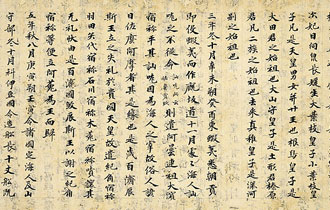Pages |
The tourism industry focusing on unique aspects of traditional Ainu culture enables the Ainu people to capitalize on their ethnic heritage by producing folk crafts to sell to tourists, as well as to find employment. Most of the tourists visiting the Shiraoi Ainu village and other sites in Hokkaidō are (Yamato) Japanese. Thus the presentation of a very different Ainu culture existing alongside the Yamato Japanese culture intensifies for the Yamato their own sense of ethnic identity, contrasted with the Ainu as the "other."
The scientific evidence for the origins of the Ainu people, language, and culture, and their relationship to the Japanese people, language, and culture, is mixed. The Ainu language is not closely related to Japanese or to any other language of East Asia, inasmuch as tools of historical linguistics available to us today can specify. There are only a few sound correspondences (one of the best indicators of genetic relationships between languages) that may be argued to suggest a relationship of Ainu to Korean and to Japanese, its closest neighbors in East Asia. The difficulty in such reconstructions is being able to sort out lexical similarities that derive from cultural borrowing with contact over time, which obviously occurred, from those linguistic similarities that derive from a common parent or proto-language in the distant past. James Patrie in The Genetic Relationship of the Ainu Language, suggests both a common origin, i.e., a genetic relationship of Ainu, Korean and Japanese, and extensive borrowing, but that the original roots of the three languages are fairly distant. The split between the three, if they shared the same linguistic root, must have occurred on the continent of Northeast Asia before the peopling of the Japanese archipelago, several tens of thousand years ago.
As with the Ainu language, the Japanese language, while clearly not related to Chinese or any of the Sino-Tibetan languages except in the written script (which Japan began to adopt wholeheartedly in beginning in the sixth century, so this similarity in itself is not a basis for their genetic affinity), shows only a few lexical and grammatical similarities to languages of the Altaic language family. In grammar, but not in the sound system or native lexicon, Japanese and Korean are almost mirror image of each other, prompting many scholars to investigate their yet-to-be-proven genetic affiliation. The connection between the Japanese and Korean languages has not been conclusively proven; in fact, it is unlikely that we'd ever know their genetic relationship. Japanese is also said to have some similarities with the Austronesian (Malayo-Polynesian) languages of the Pacific to the south of Japan. Speculations abound. Further research is necessary, but current historical linguistic methods lose their effectiveness in this case, in which the split between languages, if indeed there was a split from a common ancestral language, occurred many thousands of years ago, as may have been the case with Ainu, Japanese, and Korean.
Culture, Nationalism, and Mythology in the Search for Origins
The archeological evidence for the origins of the Ainu and Japanese peoples is not consistent with the linguistic evidence. Over the past several million years, the islands of Japan have alternately joined and separated from the continent as sea levels receded during the ice ages, then rose in periods between glaciations. The last time Japan was connected to the continent was about thirty thousand years ago, during the same period that the peopling of the New World occurred with migrations across the Bering Strait. It can be expected that with further research, evidence of earlier human habitation in the Japanese islands will be discovered, given that earlier hominid sites have been found on the continent, including the Early Paleolithic sites of the so-called Peking Man (250,000-400,000 years) and the older Lantian remains (750,000-800,000 years) in China.
Pages |











